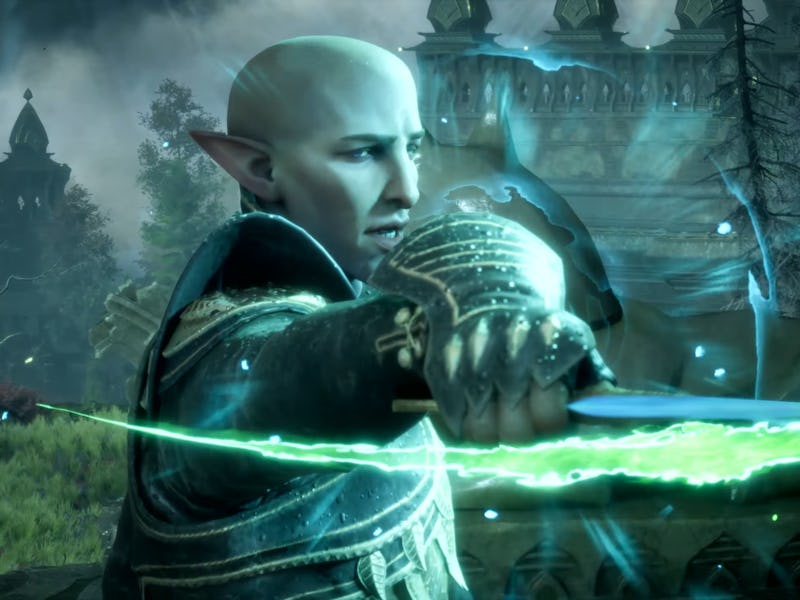Former Dragon Age Producer Says AAA Games Chasing Photorealism Is A ‘Death Cult’
Listen to the experts.

Recent gameplay from Dragon Age: The Veilguard revealed a huge graphical improvement for the series, starting with a gorgeous, bustling city and culminating in fights full of impressive visual effects. But now a former Dragon Age producer says the trend that’s leading developers to constantly push for more realistic graphics is also behind the long wait for many blockbuster games.
“We are also in a period of something I've called the 'fidelity death cult,' where a lot of games are trying for hyper-realistic art styles, hyper-high fidelity, hyper-customization, hyper-intricacy,” Mark Darrah, executive producer of Dragon Age: Inquisition said, in a video first spotted by GamesRadar+.
Mark Darrah questions whether some assumptions about blockbuster games are actually harmful in a new video.
Darrah’s comments came in a video titled “Why Do AAA Games Take So Long?” on his YouTube channel. Along with the never-ending push for graphical fidelity, Darrah points to the increase in size and complexity of many games as well. Developers may believe games that people can play for a long time — “the forever game” — sell better than those that can be finished in a few sessions and shelved. But making games with dozens of hours worth of content or with complicated systems that interact in interesting ways naturally take longer to make.
Developers may well be right that longer games do better than shorter ones, but Darrah doesn’t think that the same holds true for games that simply look better. Instead, he says the ‘fidelity death cult’ may emerge from fear of player reactions rather than genuine desire from developers.
He points to the issue of reused assets to make his point. In many cases, it might make sense for a developer to take animations, art, or entire environments from older games and use them again in new releases. However, that practice often draws the ire of some players who uncharitably accuse developers of being “lazy” for not making every bit of each new game from scratch. Moving away from the practice could certainly cut down on development time, but it would risk pushback from a group of extremely vocal players at the same time.
Would Dragon Age: Inquisition have been just as good at a smaller size?
Darrah’s comments echo ones recently made by Shawn Layden, former head of PlayStation Worldwide Studios.
"We've made a lot about the visual quality of games, the graphic quality, the resolution, the near photorealism that so many games seem to chase," Layden told GamesIndustry.biz. “But did it improve the gameplay? Did it improve the story?”
While Darrah blames the increase in fidelity for making development times unsustainably long, Layden argues that they could be distracting developers from what actually makes good fun to play.
“I don't believe you can get across the uncanny valley, I think that will always be just five steps ahead,” Layden says. “So instead of chasing that, let's go back to exciting game design.”
While Layden says that developers should focus on shorter games and give up on chasing photorealism, Darrah seems to take for granted that the AAA side of the industry isn’t going to make that change. Instead, he sees the ballooning development time of blockbuster games as a potential boon for smaller games.
Dragon Age: The Veilguard is a great example of how blockbuster game development has become far too slow.
Darrah points to the original Dark Souls as an example of a game that was “at an acceptable level of fidelity” and “big enough” to gain players’ attention, but was still able to take risks because it didn’t require the same investment as AAA games at the time. That’s not only good for players, but also for the games industry at large, Darrah says, since AAA games can then be inspired by projects made at a smaller scale to keep their own game from growing too stale.
Darrah and Layden’s statements sound similar to opinions held by plenty of indie developers, players, and critics (including here at Inverse). What makes them so interesting is that they’re coming not from outside observers but from members of the AAA games industry itself. Both Layden and Darrah have been involved in projects with exactly the problems they’re describing — some of which were even huge successes. It’s unlikely that blockbuster games will ever give up the obsessions with making games bigger, better looking, and more outrageously expensive to make, but if even the executive producer of Dragon Age: Inquisition says the industry’s priorities are holding games back, it may be time to listen.